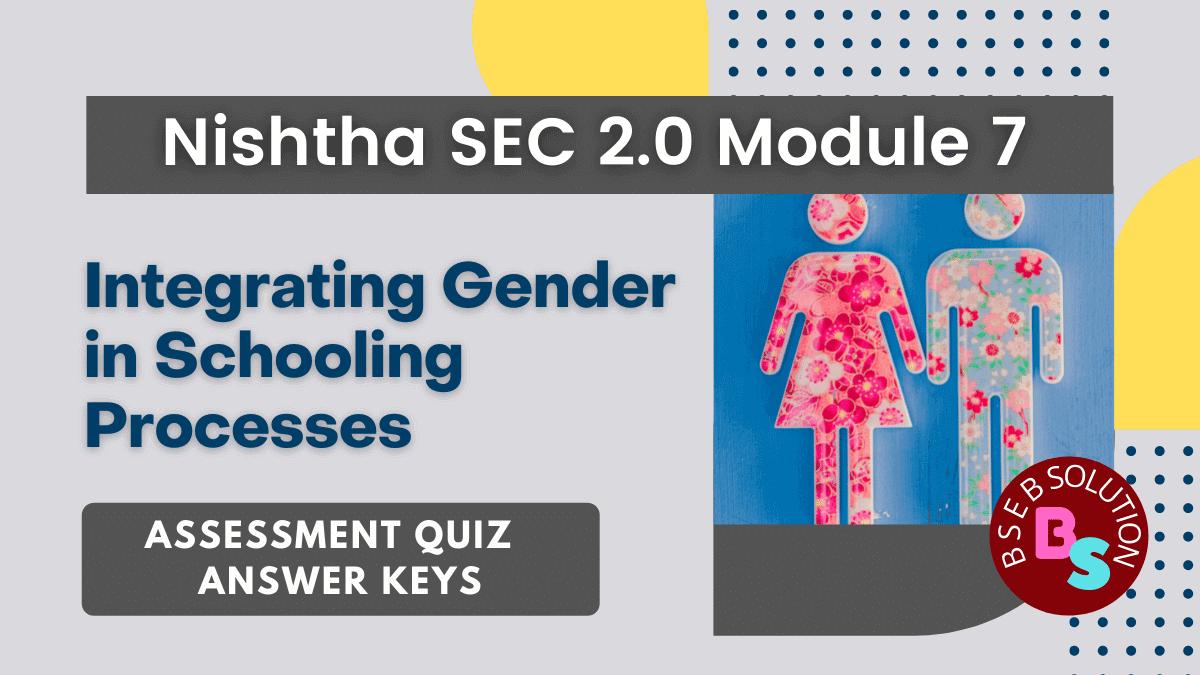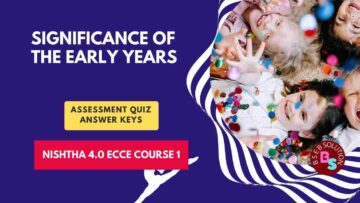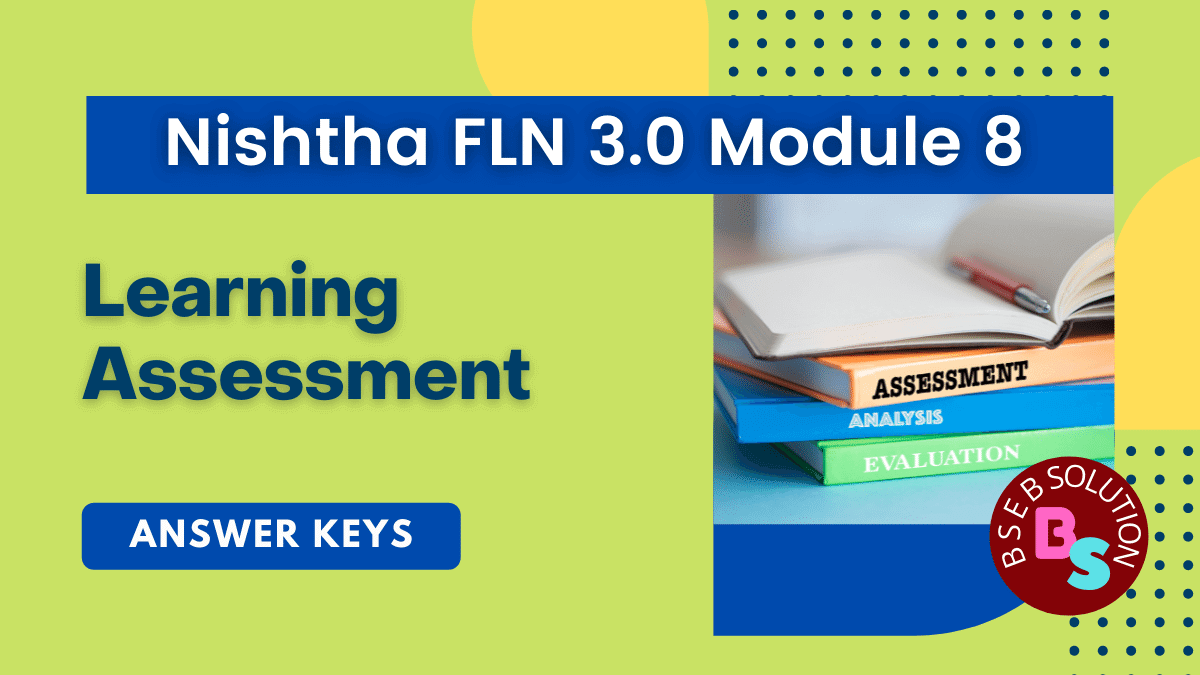The course draws attention to the concept of gender and how it operates at various levels including the schooling process. It seeks to develop a clear understanding of gender as a social construct and redefines the role of teachers and principals as facilitators who can make positive interventions towards a gender just society. In this post you will be able to know “Integrating Gender in Schooling Processes” AR, UP, UK, MZ, NL, OD, PB, AP, AS, BH, GJ, HR, HP, JK, JH, KA, MP, CHD, CG, DL, GA, MH, CBSE, KVS, NVS, MN, ML, RJ, SK, TS, TR, Nishtha SEC 2.0 Module 7 Quiz question and Answer Key PDF in English for Secondary School Teachers of all states. If you want this questionnaire in Hindi, click here.
“Integrating Gender in Schooling Processes” Nishtha SEC 2.0 Module 7
The assessment questionnaire of Nishtha 2.0 and 3.0 training is the same in all states, but the Training Links are different. Out of around 40 questions, you will get only 20 random questions in an attempt. You will be able to get the certificate by scoring 70% marks in maximum three attempts.
All the Nishtha trainings available on Diksha App are design to improve teacher performance. So, take all the training seriously and solve the assessment quiz at the end. Certificate will issued only after securing 70% marks in the evaluation quiz. If you face any kind of problem in solving Nishtha SEC 2.0 Module 7 Quiz then get complete solution here.
Nishtha SEC 2.0 Module 7 Answer Key
Q. 1: Which of the following features help in ensuring a Zero -Tolerance zone for violence in schools?
- Poor redressal mechanisms in school
- No involvement of parent and community members in the school activities.
- Safe physical infrastructures, strict code of conduct policy and strong surveillance system.
- Untrained school and support staff.
Q. 2: In Indian Society, the social norms and values are government by a system of…
- Patriarchy and matriarchy
- Matrilineal
- Matriarchy
- Patriarchy
Q. 3: The term gender refers to..
- Gender and sex are same
- A sociological construct
- Biological differences between women and men in terms of reproductive capacities.
- Equal division of labour
Q. 4: The principle of gender equality refers to..
- Equal treatment of all genders – male ,females and transgender persons
- Equal treatment of transgender children
- Equal treatment of all females
- Equal treatment of all males
Q. 5: Which of the following activities in school does not reflect gender discrimination?
- Boys are permitted to play football and cricket.
- Girls are encouraged to opt for Home Science.
- Girls and boys are equally given responsibility to serve mid-day meals.
- Teacher generally directs all questions related to Science to boys.
Q. 6: Which of the following is not a form of gender discriminations:
- Unequal access to public spaces
- Female foeticide
- Provision of equal wages to men and women
- Unequal access to digital learning to boys and girls
Q. 7: Which of the following activities are not perceived as a male-dominated activity?
- Tilling land and sowing seeds.
- Teaching in schools
- Owning a shop and doing business transactions
- Heading a village panchayat.
Q. 8: How does hidden curriculum operate in the school?
- In assigning tasks given to boys, girls and transgender
- In celebration of events and occasions within the school.
- Through organizational arrangements and in the physical spaces in schools.
- Through physical spaces and organizational arrangements, in celebration of events and occasions, in assigning tasks given to boys, girls and transgender in school.
Q. 9: How can a teacher facilitate a gender friendly classroom process?
- By performing only one-way communication and not paying attention to the individual needs of the students of all genders.
- By forming gender biases and personal opinions about individual students.
- By motivating boys to take up science and mathematics at the secondary stage.
- By encouraging the students of all genders to speak without hesitation
Q. 10: Which of the following themes in social sciences may not be appropriate to include gender dimensions:
- Population
- Historical movement for liberty and freedom
- Democracy
- Solar system
Q. 11: Which of the following statements is not a gender stereotype about boys/men?
- Boys/Men like to play with cars.
- Boys/Men should be educated more than the girls/women
- Boys/Men can cook and look after the household.
- Boys/Men are athletic and muscular.
Q. 12: Why is gender a people’s issue and not a women’s issue?
- It talks only about men and boys and their role in society.
- It concerns much more than just women’s issues.
- It concerns the issues faced by men, women, transgender persons as shaping of social mores is the responsibility of all genders.
- It concerns men and women
Q. 13: For Developing a gender just society, greater focus should be on-
- Parents
- Entire community including boys, girls, transgender children and parents
- Girls
- Boys
Q. 14: Which of the following statements is not true about women’s rights?
- They do not have equal right to pay
- They enjoy the freedom of speech.
- They have right to equal access to education
- They have the right to vote
Q. 15: Gender inclusion refers to….
- Equality among boys and girls
- Reducing discrimination and ensuring equity and equality in terms of access to resources, opportunity and facilities by all genders.
- Equal access to resources
- Bridging gender discrimination
Q. 16: What kind of learning materials should be used in the classrooms?
- Learning materials that has good visuals
- Learning materials that are sensitive to the needs of diverse groups including all gender.
- Learning materials that help students in rote learning.
- Learning materials that focus on content knowledge rather than gender issues.
Q. 17: Girls are generally made to present a bouquet to the chief guest at school functions. This is an example of which of the following?
- Hidden Curriculum
- Involvement of children in school activities
- Gender sensitivity
- Gender positivity
Q. 18: Which amongst the following may not be considered as a challenge to democracy?
- Unequal wages between men and women
- Lack of access to educational resources
- Political representation of women
- Environmental degradation
Q. 19: Which of the following sentences are ‘biological
- Men should be the only earning members of the family.
- Women undergo severe pain during menstruation.
- Men are supposed to be strong and take care of the family.
- Women are born nurturers.
Q. 20: Gender analysis helps in understanding
- Differences in social relationships between men only.
- Differences in social relationships between women, men and transgender persons.
- Differences in social relationships between women and men.
- Differences in social relationships between women only.
Q. 21: A gender friendly school environment is one where:
- Addresses the needs of the boys only.
- Understands the experiences and addresses the requirements of the boys, girls and transgender students in social and physical environment.
- There is safe physical environment.
- Only needs of the girls are addressed
Q. 22: Which of the following processes promotes gender sensitivity in the classrooms?
- Encouraging boys to respond more in classroom.
- Involving girls in decorative activities
- By ensuring careful usage of the adjectives to address boys and girls in class activities.
- By providing different roles to boys and girls.
Q. 23: A textbook of class IX has some illustrations which depict women as teachers and doctors while men as engineers and political leaders. This type of depiction is likely to promote:
- Gender discrimination
- Gender inclusion
- Empowerment of Girls
- Gender stereotype
Q. 24: Which of the following statements is not true about women’s rights?
- They enjoy the freedom of speech.
- They have right to equal access to education
- They do not have equal right to pay
- They have the right to vote
Q. 25: Which of the following activities are not perceived as a male-dominated activity?
- Tilling land and sowing seeds.
- Teaching in schools
- Heading a village panchayat.
- Owning a shop and doing business transactions
Q. 26: Which of the following features help in ensuring a Zero -Tolerance zone for violence in schools?
- Poor redressal mechanisms in school
- No involvement of parent and community members in the school activities.
- Safe physical infrastructures, strict code of conduct policy and strong surveillance system.
- Untrained school and support staff.
Q. 27: ‘Adolescence is a crucial and complex stage of the life cycle’. Which of the following attitudes/behaviors can help in overcoming anxiety and guilt among adolescents?
- Disregarding and discouraging feelings expressed by adolescents
- Negative responses from adults
- Providing a safe space to express freely and patiently listening to their problems.#
- Make them feel guilty of their actions
Q. 28: The effective integration of gender perspectives in the teaching-learning of social sciences will enable students to:
- Enhance communication skills with teachers and peers.
- Choose their careers mindfully.
- Critically examine socio-political and economic issues and question various dimensions of inequality.
- Improve skills of conducting experiments in the lab.
Q. 29: The term gender refers to-
- A sociological construct
- Gender and sex are same
- Equal division of labour
- Biological differences between women and men in terms of reproductive capacities.
Q. 30: Which amongst the following may not be considered as a challenge to democracy?
- Unequal wages between men and women
- Political representation of women
- Lack of access to educational resources
- Environmental degradation
Q. 31: How can schools provide psychological support to learners-
- By providing guidance and counseling services to learners
- By reinforcing ill effects of patriarchy within school premises.
- By having a redundant monitoring and evaluation mechanism
- By excluding the involvement of parents and community members in the activities of the school
Q. 32: Which of the following aspects does not form a part of Gender Auditing of school environment –
- Gender safe Access and Safety and Security for discriminated genders.
- Providing Counseling and Support Service.
- No Zero Tolerance policy against gender violence and discrimination
- Involvement of Parents, prospective employers and Community Members.
Q. 33: Which of the following sentences can help in removing feelings of alienation in learning environment among girls and transgenders children?
- Discriminatory attitude of teachers in terms of selective distribution of roles and responsibilities.
- Representation of women and transgender children in passive roles.
- Positive and equal representation of girls and transgender children in learning material as well as pedagogical processes.
- Inability to identify with content
Q. 34: How can teachers provide a sensitive class environment?
- By ignoring behavior of children who seem vulnerable irrespective of their gender.
- By being friendly with them.
- By treating girls better than boys.
- By creating a safe space for children, being respectful of their needs, being available to listen and ready to unlearn their own biases.
Q. 35: Which of the following statements is not a gender stereotype about girls/women?
- Girls/Women are talkative
- Girls/Women should be thin and graceful.
- Girls/Women have leadership skills and can excel in any profession.
- Girls/Women are bad Decision Makers
Q. 36: How does hidden curriculum operate in the school?
- In assigning tasks given to boys, girls and transgender.
- Through physical spaces and organizational arrangements, in celebration of events and occasions, in assigning tasks given to boys, girls and transgender in school.
- Through organizational arrangements and in the physical spaces in schools.
- In celebration of events and occasions within the school.
Q. 37: How can we ensure gender sensitive transactions of disciplines?
- By questioning socially constructed ideas, institutions, and practices related to gender within the disciplines.
- Under representing the participation of all genders.
- By providing visuals of men, women and transgender in gender stereotypical roles.
- Neglecting participation and contribution of women in political, social, cultural, and environmental processes.
We hope that you have found the answer key for Nishtha Secondary 2.0 Module 7 ‘Integrating Gender in Schooling Processes’ Quiz, which helped you. Read the solutions of the quiz for modules other than “Integrating Gender in Schooling Processes” Nishtha Module 7 answer key by clicking the button below.
Get here the link of training for all English medium state boards available on Diksha App. In this you will know the list of all the latest training and the last date of the training course.
If you have any suggestions regarding Nishtha 2.0 Secondary Module 7 quiz answer key, please send to us as your suggestions are very important to us..







